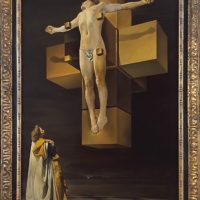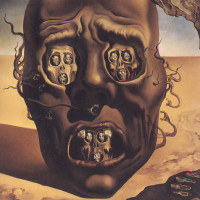| Painting Name | Portrait of Picasso |
| Painter Name | Salvador Dali |
| Completion Date | 1947 |
| Technique | Oil |
| Material | Canvas |
| Current Location | Gala-Salvador Dali Foundation Figueras Spain |
This is an ambivalent painting of cubist artist Pablo Picasso by the surrealist master Salvador Dali produced in the year of 1947.
Portrait of Picasso Analysis
The surrealist portrait painting of Pablo Picasso by Salvador Dali is infused with symbolic messages and meanings as Dali’s most famous works are.
Basically, instead of a direct face, it is a portrait of Picasso’s bust sculpture. The base of the bust is made out of the regular white stone out of which most bust-sculptures are made of. But, the upper part is covered with skin. There is a white flower in the distorted chest of the bust, while a red one, is laying at the feet of the bust.
The head is much more distorted than the chest with empty eye sockets, horned nose, open mouth with drooling tongue. Depicted brain resembles to goat’s round horns. It is covered from top to back of the head with unnaturally thick white hair which seems to be made out of the same material as the white base of the bust. A thick thread of hair is prolonged from the back end of the hairs which comes out through the mouth and turns into a prolonged spoon in front of the distorted face. The spoon holds a little Lute at the end. Lutes are symbol of love or sexual motifs. That symbolism is backboned with the drooling tongue. Over the head lingers a yellow rock.
The background is made out of two shades of brown with dark brown at the corners while the brown with yellowish tint covers the bust itself.
Ambivalent Depiction
It is a known fact that Dali being more than 20 years smaller than Picasso, respected him a lot. Age difference wasn’t the only reason for him to give him respect. During the Dali’s first solo exhibition in Barcelona, Picasso came after hearing about Dali’s excellence of painting. The young Dali was happy to see such big artist at his exhibition. His visit resulted in Picasso liking Dali’s work and he loaned Dali five hundred dollars for the trip to America. Both were Spanish painters.
Though, over the years, their acquaintance and friendship saw many up and downs as both of them got famous among the common people (Picasso was already popular when he visited Dali’s exhibition).
This painting was produced in 1947 when also Dali was a popular figure. Although, claiming Picasso to be his artistic father, Dali disliked Picasso’s “ugliness” of paintings. According to him, Picasso’s painting had started to lose the aesthetic properties which Dali’s always included in the most of his paintings. This difference caused some sparks between their relationships.
The painting is mixed bag of feelings of Dali for Picasso, though, the prominence is Dali’s dislike for Picasso’s ‘ugly’ paintings. Dali went a step further and called Picasso as the “destroyer of art”.
Conveying his message of Picasso ignoring artistic aesthetics in his painting by depicting a distorted face of Picasso, Dali also included his respect by depicting him as a bust and adding a flower at his chest. Bust sculptures represent important people in history, while the flower in the chest could be understood as the symbol of ‘good-at-heart’ notion.
It is always amusing to know how the greatest minds of any contemporary times coordinated with each other after achieving the legendary status during their lifetime, whether it is Dali and Picasso’s relationships or Michelangelo and Raphael’s rivalry.
Allegedly, Picasso’s response on this work weren’t much enthusiastic. The painting is currently placed in Gala-Salvador Dali Foundation, Figueras, Spain.





